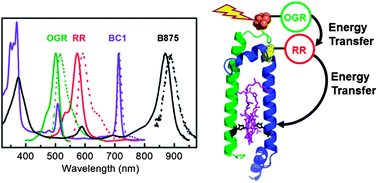Integration of multiple chromophores with native photosynthetic antennas to enhance solar energy capture and delivery†
Abstract
Native length bacterial light-harvesting

* Corresponding authors
a
Department of Chemistry, Washington University, St. Louis, MO 63130-4889, USA
E-mail:
holten@wustl.edu
b
Department of Molecular Biosciences, Northwestern University, Evanston, IL 60208-3500, USA
E-mail:
p-loach@northwestern.edu
c
Department of Chemistry, North Carolina State University, Raleigh, NC 27695-8204, USA
E-mail:
jlindsey@ncsu.edu
d
Department of Molecular Biology and Biotechnology, University of Sheffield, Sheffield S10 2TN, UK
E-mail:
C.N.Hunter@sheffield.ac.uk
e
Department of Chemistry, University of California, Riverside, CA 92521-0403, USA
E-mail:
david.bocian@ucr.edu
Native length bacterial light-harvesting

 Please wait while we load your content...
Something went wrong. Try again?
Please wait while we load your content...
Something went wrong. Try again?
M. A. Harris, P. S. Parkes-Loach, J. W. Springer, J. Jiang, E. C. Martin, P. Qian, J. Jiao, D. M. Niedzwiedzki, C. Kirmaier, J. D. Olsen, D. F. Bocian, D. Holten, C. N. Hunter, J. S. Lindsey and P. A. Loach, Chem. Sci., 2013, 4, 3924 DOI: 10.1039/C3SC51518D
To request permission to reproduce material from this article, please go to the Copyright Clearance Center request page.
If you are an author contributing to an RSC publication, you do not need to request permission provided correct acknowledgement is given.
If you are the author of this article, you do not need to request permission to reproduce figures and diagrams provided correct acknowledgement is given. If you want to reproduce the whole article in a third-party publication (excluding your thesis/dissertation for which permission is not required) please go to the Copyright Clearance Center request page.
Read more about how to correctly acknowledge RSC content.
 Fetching data from CrossRef.
Fetching data from CrossRef.
This may take some time to load.
Loading related content
